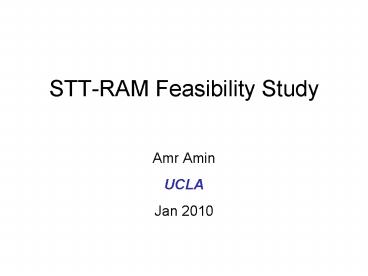STT-RAM Feasibility Study PowerPoint PPT Presentation
1 / 21
Title: STT-RAM Feasibility Study
1
STT-RAM Feasibility Study
- Amr Amin
- UCLA
- Jan 2010
2
Outline
- Introduction
- Memory Cell
- Cell Area Calculation
- Write Current Limitations
- Reading Techniques and Limitations
- Effect of Process Variations and Mismatch
- MTJ Feasible Region
- Area Minimization
3
Introduction
- The need for a universal memory
- Brief history of magnetic device memories
- Description of the MTJ device
- Literature survey
- Summary of the paper flow
4
STT-RAM Cell
- Schematic diagram
- Anti-parallelizing / Parallelizing currents
- Read disturb problem
- Cell layout
- Basic cell area vs. access device width
5
Effective Cell Area
- This takes into account the overhead of
- Column MUX
- Row decoder
- Sense Amp
- I/O circuits
- Area optimization should also consider
- Optimum memory partitioning
- Access transistor vs. column MUX areas
6
Write Current Limitations
- MOS drain current equation and fitting
- Maximum allowed RP and RAP for certain write
current(s) - Column MUX design (justification for using
T-gates instead of P-transistors) - Effect of each of the four MUX devices on the
maximum allowed resistances
7
NMOS Drain Current
8
PMOS Drain Current
9
Maximum RAP
10
Maximum RP
11
Reading Limitations
- Current sensing
- Voltage sensing
12
Constant Read Signal Contours
- Current Sensing
- Voltage Sensing
13
Process Variations
- MOS variations
- Min K and max VT
- Reduce the maximum allowed RP and RAP
- Mismatch
- Degrades sensitivity of the SA
- Higher nominal read margin is required
- MTJ variations
- MgO thickness and area variations
- Distort the nominal feasible region of the MTJ
14
Process Variations
15
MTJ Feasible Region
- What is the MTJ feasible region in the RPRAP
plan given the following - Desired write current
- Desired basic cell area
- Column MUX width
- Certain technology
- Certain variations (Yield)
- Matching parameters (Yield)
16
Dec-2009 Tape-out
- IBM-90nm-CMOS
- VWL VDD 1 V
- IWR 500 µA
- Wa2.56 µm
- WP,MUX16 µm
- WN,MUX8 µm
- MOS K varies /- 20
- MOS VT varies /- 50mV
- MTJ RA 2 O.µm2
- MTJ KRA 34 O.µm2/nm
- MTJ TMR 100
- MTJ KTMR 200 /nm
- MTJ ?tMgO 0.2 Ao
- Current Sensing VR 600 mV
- Current Sensing ?IR 20 µA
17
SRAM-Area Constraint
- IBM-90nm-CMOS
- VWL VDD 1 V
- IWR 500 µA
- Wa2.56 µm
- WP,MUX16 µm
- WN,MUX8 µm
- MOS K varies /- 20
- MOS VT varies /- 50mV
- MTJ RA 2 O.µm2
- MTJ KRA 34 O.µm2/nm
- MTJ TMR 100
- MTJ KTMR 200 /nm
- MTJ ?tMgO 0.2 Ao
- Current Sensing VR 600 mV
- Current Sensing ?IR 20 µA
18
Flash-Area Constraint
19
DRAM-Area Constraint
20
Area Minimization Problem
- Minimize Effective cell area
- Subject to
- MTJ resistances and write current value
- MTJ variations
- Parallelizing/Anti-parallelizing Write current
equations - MOS variations and matching parameters
- Speed must come into picture to constrain the
optimum memory partitioning - May be able to formulate this into a standard
optimization problem form that can be solved
efficiently
21
Remaining Issues
- Analyzing Read/Write Speed and adding this as a
constraint in the optimization problem - The same with power
- More analysis is needed for the minimum required
sensing signal (current or voltage) - CMOS mismatches and offset
- Signal degradation due to MgO thickness variation
- Possible signal degradation due to CMOS process
variation (dependant on the SA implementation) - Regenerating all results for different
technologies

